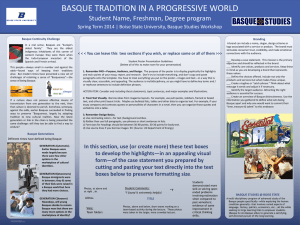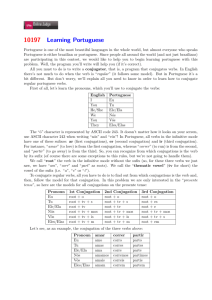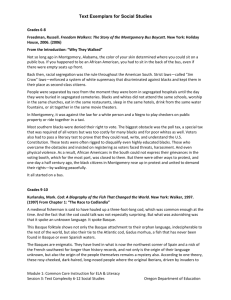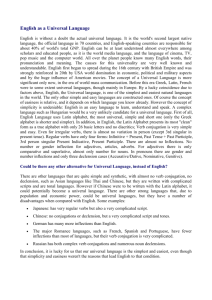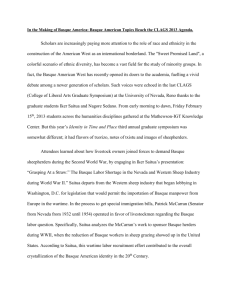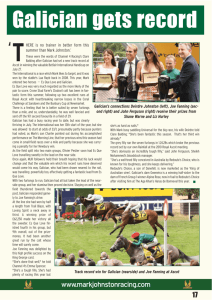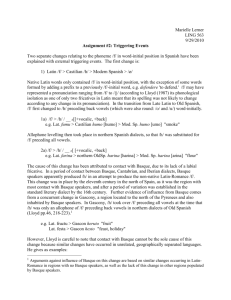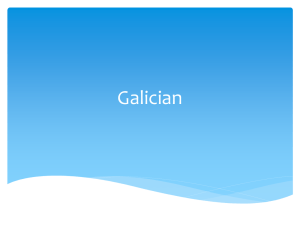Language Matters activity 6 grammatical paradigms
advertisement
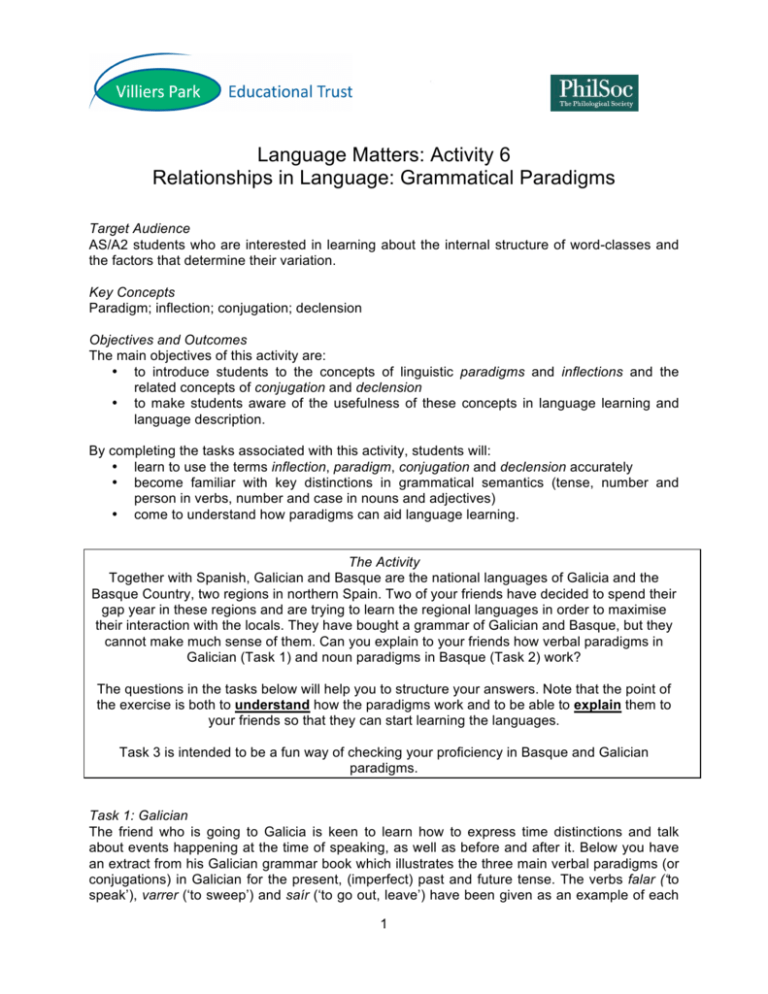
Language Matters: Activity 6 Relationships in Language: Grammatical Paradigms Target Audience AS/A2 students who are interested in learning about the internal structure of word-classes and the factors that determine their variation. Key Concepts Paradigm; inflection; conjugation; declension Objectives and Outcomes The main objectives of this activity are: • to introduce students to the concepts of linguistic paradigms and inflections and the related concepts of conjugation and declension • to make students aware of the usefulness of these concepts in language learning and language description. By completing the tasks associated with this activity, students will: • learn to use the terms inflection, paradigm, conjugation and declension accurately • become familiar with key distinctions in grammatical semantics (tense, number and person in verbs, number and case in nouns and adjectives) • come to understand how paradigms can aid language learning. The Activity Together with Spanish, Galician and Basque are the national languages of Galicia and the Basque Country, two regions in northern Spain. Two of your friends have decided to spend their gap year in these regions and are trying to learn the regional languages in order to maximise their interaction with the locals. They have bought a grammar of Galician and Basque, but they cannot make much sense of them. Can you explain to your friends how verbal paradigms in Galician (Task 1) and noun paradigms in Basque (Task 2) work? The questions in the tasks below will help you to structure your answers. Note that the point of the exercise is both to understand how the paradigms work and to be able to explain them to your friends so that they can start learning the languages. Task 3 is intended to be a fun way of checking your proficiency in Basque and Galician paradigms. Task 1: Galician The friend who is going to Galicia is keen to learn how to express time distinctions and talk about events happening at the time of speaking, as well as before and after it. Below you have an extract from his Galician grammar book which illustrates the three main verbal paradigms (or conjugations) in Galician for the present, (imperfect) past and future tense. The verbs falar (‘to speak’), varrer (‘to sweep’) and saír (‘to go out, leave’) have been given as an example of each 1 of those three conjugations. A translation is given below for each form. The corresponding personal pronouns are included. Have a look at the table and answer the questions below. Conjugation 1 Falar (‘to speak’) Pronouns Eu I Tí You (singular) Él/ela He/she Nós We Vós You (plur.) Eles They Falo Speak Falas Speak Fala Speaks Falamos Speak Falades Speak Falan Speak Eu I Tí You (sing.) Él/ela He/she Nós We Vós You (plur.) Eles They Falaba spoke/was speaking Falabas spoke/were speaking Falaba spoke/was speaking Falabamos spoke/were speaking Falabades spoke/were speaking Falaban spoke/were speaking Eu I Tí You (sing.) Él/ela He/she Nós We Vós You (plur.) Eles They Falarei Will speak Falarás Will speak Falará Will speak Falaremos Will speak Falaredes Will speak Falarán Will speak Conjugation 2 Varrer (‘to sweep’) Present Varro Sweep Varres Sweep Varre Sweeps Varremos Sweep Varredes Sweep Varren Sweep Past Varría Swept/was sweeping varrías Swept/were sweeping Varría Swept/was sweeping Varriamos Swept/were sweeping Varriades Swept/were sweeping Varrían Swept/were sweeping Future Varrerei Will sweep Varrerás Will sweep Varrerá Will sweep Varreremos Will sweep Varreredes Will sweep Varrerán Will sweep Conjugation 3 Saír (‘to go out’) Saio Go out Saes Go out Sae Goes out Saímos Go out Saídes Go out Saen Go out Saía Went out/ was going out Saías Went out/ were going out Saía Went out/ was going out Saiamos Went out/ were going out Saiades Went out/ were going out Saían Went out/ were going out Sairei Will go out Sairás Will go out Sairá Will go out Sairemos Will go out Sairedes Will go out Sairán Will go out (1) What is the criterion that determines whether a Galician verb belongs to the first, second or third conjugation? (2) How do Galician verbs indicate futurity? And (imperfect) pastness? (3) What kind of grammatical information do the inflections -mos, -des, -án (e.g., falaremos, comeredes, sairán) convey? If you have answered the questions correctly, you should be able to help your friend work out the conjugation (present/past/future tenses) of the following two verbs: chamar (‘to call’) and comer (‘to eat’). The personal pronouns (I/you/we etc.) have been provided. 2 Present Past Future Chamar (‘to call’) Eu ___________ Tí ___________ Él/ela ________ Nós __________ Vós __________ Eles/elas ________ Eu___________ Tí___________ Él/ela___________ Nós__________ Vós___________ Eles/elas___________ Eu___________ Tí___________ Él/ela___________ Nós___________ Vós___________ Eles/elas__________ Comer (‘to eat’) Eu ___________ Tí___________ Él/ela ___________ Nós ___________ Vós ___________ Eles/elas__________ Eu___________ Tí___________ Él/ela___________ Nós___________ Vós___________ Eles/elas__________ Eu___________ Tí___________ Él/ela___________ Nós___________ Vós___________ Eles/elas_________ (4) What have you discovered about English verb inflections in the course of learning Galician? Task 2: Basque Task 2.1 Your other friend is trying to make sense of how nouns are inflected for number (i.e., singular vs. plural) in Basque. His book provides some examples of simple noun phrases: see examples 1–9 in the table below. Help your friend by: (1) doing a word-for-word translation of examples 2–9 (2) providing the missing Basque examples in 10–14 and their corresponding word-for-word translation (3) writing a rule that explains how the plural inflections work in Basque nouns in simple noun phrases. Basque 1. Emakume 2. Emakumea 3. Emakume gaztea 4. Emakumeak 5. Emakume itsusiak 6. Gizon argali 7. Gizonak 8. Etxe handiak 9. Txakur txikiak 10. 11. 12. 13. English translation ‘woman’ ‘the woman’ ‘the young woman’ ‘the women’ ‘the ugly women’ ‘the thin man’ ‘the men’ ‘the big houses’ ‘the small dogs’ ‘the man’ ‘young’ ‘the houses’ ‘the big dogs’ 3 Word-for-word translation ‘woman’ ‘woman-the’ 14. ‘the ugly house’ Rule: ____________________________________________________________________________ ___________________________________________________________________________ Task 2.2 Success! Your explanations have helped a lot. Your friend starts to feel more confident about learning Basque, so he decides to try some of the ‘fill-the gap’ exercises that appear in his grammar book. However, he hasn’t realised that nouns (e.g., car, house) in Basque are also inflected for case (i.e., the syntactic function that the noun has in the sentence). Below you see: (1) (part of) the declension (paradigm) of the noun mutil (‘boy’). The added inflections are in bold (2) the ‘fill-the-gap’ exercise that your friend has completed Correct any mistakes that he has made and explain what he has done wrong. (1) (Partial) declension of the noun ‘boy’ (mutil) in Basque Name of the inflection in Basque and translation Mutil (‘boy’) Singular Mutila Mutilaren Mutilarekin Mutilarentzat Nor (the ‘doer’ of the action) Noren (answers the question ‘whose?’) Norekin (answers the question ‘with whom?’) Norentzat (answers the question ‘for whom?’) Plural Mutilak Mutilen Mutilekin Mutilentzat (2) ‘Fill-the-gap’ exercise The capitalised and underlined words in each sentence indicate the word required in the gap. Basque sentence English translation What your friend wrote in the gap Urtero ______ oporretan joaten dira. The STUDENTS go on holiday every year. (Ikasle ‘student’) Ikasleak Neska hori ____ etorri zen. ____ argalarentzat opari bat erosi genuen. ____ kotxea apurtuta dago. That girl came with the BOYS. (Mutil ‘boy’) We bought a present for the thin MAN. (Gizon ‘man’) His SON’S car is broken. (Seme ‘son’) Correct? If so, mark with √. If not, write in the correct form(s) and explain why your friend’s answer is wrong. Mutilak Gizon Seme Task 3 We hope that you have become a confident user of the terms inflection, paradigm, conjugation and declension. Test your knowledge of Galician and Basque inflections by completing the 4 following crossword. For each clue, you should enter the Galician/Basque equivalent of the capitalised word, with the right inflection of course! The relevant words are given in brackets at the end of each sentence. Going Further • This website <http://www.verbix.com/languages/> allows you to check the conjugation of verbs in different languages. (If you don’t know what the verbal equivalent of ‘to do’ or ‘to find’ is in language X or Y, you can always use the translate tool <http://www.verbix.com/translate/>. Please be very careful when using the tool. As we saw in Activity 4, automated translation does not always provide you with the word you are looking for. You may also want to use the online dictionaries mentioned in the activity to double- or triple-check the results you got from the verbix translate tool.) 5 • Compare the paradigm for the (simple) present and/or future tenses of a given verb in related languages (e.g., Galician, French and Italian as Romance languages as opposed to German and Dutch as Germanic languages). For each language, identify the verbal inflections and work out what their function is (e.g., to indicate person/number or tense). Do you notice any systematic similarities across language families? © Villiers Park Educational Trust 2013 6
